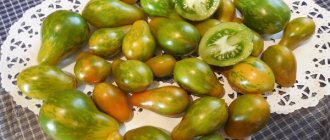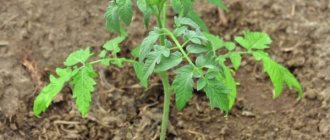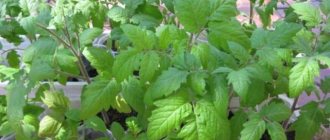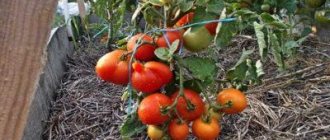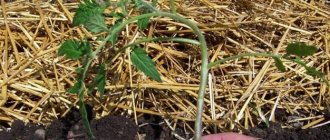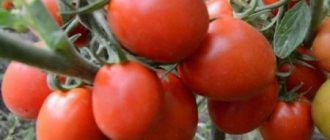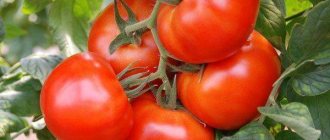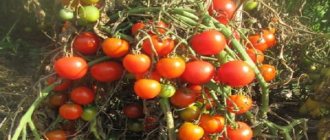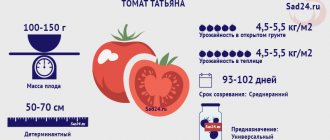Vegetable growing » Tomatoes
0
2231
Article rating
Kira Stoletova
To taste real southern tomatoes, with a fleshy center and sweet pulp, you need to grow Yusupov tomatoes. The seeds of these vegetables are rarely sold anywhere, but an experienced gardener who knows where to find them, since he has been growing tomatoes for many years, can help in this matter.
Characteristics and description of Yusupov tomatoes
Tomatoes Fleshy sugary: variety description
| Variety name | Fleshy sugary |
| general description | Mid-season indeterminate variety |
| Originator | Russia |
| Ripening period | 95-105 days |
| Form | Round, slightly elongated |
| Color | Pink |
| Average weight of tomatoes | 250-500 grams |
| Application | Universal |
| Productivity of the variety | 10-12 kg per sq.m. |
| Features of cultivation | The variety responds well to fertilizing containing phosphorus and potassium |
| Disease resistance | Prevention of Phomasis is needed |
This is a tall tomato variety, its height exceeds the standard size of ordinary plants.
The bush is of indeterminate type and belongs to standard plants. From planting seedlings to the ripening of the first fruits, 95-105 days pass, that is, it is mid-early. Recommended for growing both in greenhouse shelters and in open ground. Ripe fruits have a bright pink color, they are round in shape, slightly elongated. The tomatoes themselves are not small, their weight is 250-280 g. Especially large tomatoes are harvested at the first fruiting; their weight can reach 400-500 grams. The number of chambers is 6-7, the dry matter content is approximately 5%. The fruits have a pleasant taste and bright aroma.
The “Fleshy Sugary” tomato was obtained in Russia by our specialists and received state registration as a variety recommended for planting in greenhouses and open ground in 2006. Thanks to its varietal qualities, it has gained popularity among gardeners and farmers. In the southern regions, regardless of where this tomato is grown in greenhouses or in open ground, it gives very good results. In the regions of central Russia and more northern regions, it can also be grown, but the yield may drop significantly.
You can compare the weight of the fruits of this variety with others in the table below:
| Variety name | Fruit weight |
| Fleshy sugary | 250-500 grams |
| Big Mama | 200-400 grams |
| Banana legs | 60-110 grams |
| Petrusha the gardener | 180-200 grams |
| Honey saved | 200-600 grams |
| Beauty King | 280-320 grams |
| Pudovik | 700-800 grams |
| Persimmon | 350-400 grams |
| Nikola | 80-200 grams |
| Right size | 300-800 |
Description of tomatoes
| Variety name | Yusupovsky |
| general description | Late-ripening, indeterminate, tall variety with large fruits. Recommended for greenhouses. |
| Originator | Research Institute of Vegetables and Melons of Uzbekistan |
| Ripening period | 110-115 days |
| Form | The fruits are large, flat-round. |
| Color | The color of ripe fruits is pink-red. |
| Average weight of tomatoes | 500-600 grams |
| Application | Good fresh, suitable for juices and sauces. |
| Productivity of the variety | high |
| Features of cultivation | Sowing seeds for seedlings is carried out 60-70 days before planting. Requires tying to the support and pinning. |
| Disease resistance | Yusupov tomatoes are resistant and not susceptible to cladosporiosis. Like all greenhouse varieties, they can become infected with late blight, apical and gray rot, black leg, and fusarium wilt of fruits. |
Not a hybrid.
It has no hybrids of the same name. Bred in the experimental fields of the Research Institute of Vegetables and Melons of Uzbekistan. The author of the variety is Uzbek breeder Karim Yusupov. Yusupov tomatoes, or as they are also called Uzbek tomatoes, have an indeterminate, tall, strong bush. When grown in open ground, it reaches a height of 80 cm. In greenhouses it can reach up to 160 cm. Read about determinate varieties in this article.
The leaf is ordinary, green. The foliage is medium-strong.
Harvest tomato. In the homeland of the variety in Uzbekistan, the weight of the fruit often exceeds a kilogram. In the Russian climate, provided that it is grown in a greenhouse or greenhouse, the weight of the fruit is from 400 to 800 grams. In open ground - from 200 to 500 g.
The variety forms strong clusters. The fruits ripen uniform in size even on the upper branches. Flowering lasts from June to August. According to the ripening period, it belongs to late varieties.
These tomatoes have no name or brand. I call these tomatoes 'Uzbek'. In early spring (late April-early May) we usually buy tomatoes at the market. 'Uzbek'At this time there are few tasty tomatoes. We usually sell tomatoes under the names 'Uzbek', 'Moldavian' and 'Krasnodar'. I remember I took several different ones to try.
I liked the Uzbek ones. I can’t say that they are very sweet and tasty, which I later collect in the greenhouse, but in the absence of these and compared to the store-bought ones, I really liked them. Tomatoes And so I took the seeds from these Uzbek ones and planted them last year. What I really liked about them was their productivity and keeping quality.
This is the best for pickling. Green bushes are not tall, about 80 cm, and are resistant to various diseases. I planted it, like everyone else, in early March in purchased land. I didn’t fertilize it with anything. I planted it in the greenhouse at the end of April. The bush is so strong. After 2 weeks, I fed it first with a mash of greens and bread, then with the addition of chicken manure and ash.
Tomato Yusupovsky from the Uzbekistan family. The variety is intended for cultivation in greenhouses. Description of Yusupov tomatoes - tall fruits and late ripening. The tomato itself is large in size and quite meaty. It is characterized by a pink (slightly red) color. The weight of one fruit is 400-600 g. The Uzbek tomato, its genus was created by breeders of the Uzbek Research Institute. He was named after the famous breeder Karim Yusupov. This variety is the best of all large tomatoes.
A tomato bush reaches a height of 1.8 m. If you plant seedlings in open ground, then the bush will grow only 60 cm. During growth, the plant must be tied up. The leaf is ordinary, it is advisable to form it into 2 stems. In addition, the plant is pruned for better yield. Planting of seedlings is carried out in June or July. After this, after 60-65 days you can harvest a wonderful harvest.
Yusupov tomatoes grow very tasty. They grow well in the south of the country and in the north. Because of their large fruits, Uzbek tomatoes resemble hybrids, but this is not the case. Every year the seeds change, but still retain all the qualities of a wonderful tomato. The center has a dessert taste, juicy and very sweet. There is not even any sour tones in the tomato.
Tomatoes are well suited for making salads and eating fresh. They will make very tasty and sweet juice. The fruits do not like to lie for a long time after picking, so they are eaten immediately.
The best varieties of low-growing tomatoes
The height of the bushes of low-growing tomato varieties usually does not exceed 50-80 cm. Many of them are early ripening. You can grow short varieties of tomatoes not only in a greenhouse or in open ground, but also on the balcony and in the apartment.
Tomato White filling
The tomato variety Belyi naliv (Belyi naliv 241) received its unusual name for the milky color of the fruit, which is inherent in them at the beginning of ripening. Over time, the skin begins to darken and acquires its usual red color by harvest. An early ripening variety, productive, easy to care for - these are its qualities that attract many summer residents.
Tomato Boni MM
The height of the Boni MM tomato bush is 40-50 cm. This is one of the earliest ripening varieties: you can enjoy the harvest within 80 days after germination. Boni MM quickly takes root after transplantation, is resistant to many diseases, and does not require pinching. The fruits are suitable for both canning and fresh consumption.
Tomato Aztec
Another low-growing variety whose fruits gardeners love to grow in summer cottages is Aztec. Small (20-30 g) tomatoes at the moment of active ripening literally cover the entire bush. Many people grow low bushes (up to 40 cm) not only in the country, but also in apartments on the windowsill. Aztec tomatoes, transferred to a warm, bright room, can bear fruit until frost.
Description and characteristics of the variety
Tomato Yusupovsky is part of a large group of tall indeterminates. Initially intended for planting in greenhouses, as it loves warmth.
The variety is not a hybrid. Its creator, Karim Yusupov, is a famous master breeder from an Uzbek research institute.
Characteristics of bushes:
- large, strong, powerful;
- shoot height 1.7-2 m;
- moderate branching;
- pronounced foliage;
- shoots are prone to excessive growth;
- 5 ovaries are formed on the hands;
- There are 7-8 fruiting clusters in total.
Ripening occurs late - after 130-135 days from full germination.
Description of the legendary delicacy tomatoes:
- average weight 500-600 g;
- crimson-red color with iridescence;
- moderate ribbing at the stalk;
- the pulp is oily and fleshy;
- the skin is strong, thin, does not crack;
- seed chambers within 6, seeds are small and there are very few of them;
- dry matter 5-6%;
- sugar content 5%;
- the shape is flat and flattened.
Protection from diseases and pests
Uzbek tomatoes are resistant to fusarium and cladosporiosis, and are less likely to suffer from blossom end rot and blackleg than other varieties. However, there is no immunity to late blight. Therefore, it is important to maintain optimal humidity in the greenhouse and treat plants as a preventive measure with a 1% solution of Bordeaux mixture.
Modern insecticides are effective in protecting against insects.
Tomato care
Yusupov tomatoes are demanding to care for. They love frequent watering, fertilizing and careful treatment against diseases and pests.
If you provide tomato plants with constant care and attention, the harvest will be abundant and healthy. And this is the highest praise for a tomato grower - to get a lot of tasty and beautiful fruits
Watering
Yusupov tomatoes, due to their special gigantic size, require a lot of water. They need to be watered moderately but abundantly, directing the stream directly under the root of the plant.
If all the moisture gets to the roots, the rhizome becomes powerful and highly developed. It nourishes all above-ground parts more intensively, forcing the formation of larger fruits.
However, it is still recommended to water tomatoes sparingly, as tomatoes may acquire a watery taste and will also be more susceptible to rot and cracking.
When watering, do not use the sprinkling method, since with this method water gets on the leaves and fruits, which can lead to the development of fungal deposits.
Top dressing
In growing such large-fruited tomatoes as Yusupovskie, fertilizing plays a special role. They must be carried out in a timely and competent manner, otherwise you may not get a lot of kilograms of tomatoes. No, this does not mean that some exorbitant doses of fertilizers are needed.
Conventional fertilizers, mostly organic, are suitable for growing. And of course, you can’t do without wood ash, humates and microelements.
During the first growing season, the bushes intensively increase their green mass. For this, plants need nitrogen. However, in greenhouse conditions, its quantity should not be too large, otherwise you may end up with continuous bushes rather than evenly growing bushes.
Therefore, you need to feed plants with nitrogen-containing mixtures carefully, observing the measure. It is optimal to arrange root feeding with mullein solution, bird droppings, urea or nettle infusion.
The next significant stage in the development of tomato bushes is their flowering. This time, the plants give all their energy and all the accumulated nutrition to fruit set.
In order for the process to proceed as intensively and on a larger scale as possible, tomatoes need phosphorus-potassium fertilizers. You can use complex mineral fertilizers, feed with superphosphate and boric acid.
The third time, fertilizing is applied during the ripening period of the first wave of the crop. This time both mineral and organic fertilizers are applied. Plants respond well to feeding with nettle extract.
All fertilizers must be combined with watering, since applying fertilizers “dry” causes the soil to become salty, and the root system does not absorb nutrients.
Compliance with greenhouse conditions
Everyone knows that a special humid-warm microclimate is created in a greenhouse. If left unchecked, plants will not develop properly.
It is important to observe three fundamental factors - temperature, humidity and lighting
Seedlings grow comfortably at a temperature of 18-20 degrees. If it gets colder, then plant growth slows down, and when it gets too hot in the greenhouse, the bushes simply burn out and drop all their flowers, and the pollen becomes sterile.
Sunlight is also important for tomatoes. Especially during the formation of flowers, as well as during the period of intensive ripening of fruits (their filling), they need ultraviolet light.
Living in the shade, the plants become very elongated, and the fruits grow small and not so juicy.
Therefore, in order to protect plants from the occurrence of illnesses, you need to carry out regular ventilation, and also adhere to the correct seating scheme - do not plant the bushes too close to each other and make holes for tomatoes in a checkerboard pattern.
Support and garter
All tall tomatoes need additional support. The bushes are tied to stakes placed nearby or to a specially made trellis. Both the main stems and branches with fruits are knitted. Keep in mind that the thread should not pull the branches, otherwise they will dry out.
It is necessary to remove all excess ovaries. No more than 8 flowering clusters are left on the stem.
sveklon.ru
Growing tomatoes
Below we describe how to properly grow this variety of tomatoes.
How to prepare seeds?
Pre-planting treatment of the seed with a solution of potassium permanganate is carried out, this will provide the seeds with immunity from various diseases. To ensure quick germination of seeds, they are soaked in a growth stimulator.
Sowing seed material
REFERENCE: Yusupov seedlings have a powerful root system; they need a lot of space. Choose spacious containers for seedlings.
Seeds for seedlings are sown 60-65 days before the planned transplantation to a permanent place. For friendly and powerful growth of seedlings, seedlings must be provided with a sufficient amount of sunlight (use additional artificial lighting) and heat (from +22 to +25 ºС). When the first blossoming leaves appear, the seedlings must be planted in separate containers.
Rules for planting seedlings
The area for tomatoes needs to be prepared in advance:
- Tomatoes prefer light, loose and nutritious soil. When digging, add a sufficient amount of compost to the ground (humus is used instead of fresh manure), potassium-phosphorus fertilizers;
- Plant seedlings in well-warmed soil;
- Wood ash and superphosphate are added to shallow holes, followed by abundant watering;
- The distance between holes is 40 cm, row spacing is at least 60 cm;
- The seedlings are transplanted using the transshipment method, laying out the roots at the bottom of the hole;
- Then fill the plant with dry soil and water again.
Bush care
This variety has increased care requirements. They need to be frequently watered, fed and treated against diseases and pests.
Constant care and attention will ensure a bountiful and healthy harvest.
IMPORTANT: It is not recommended to water by sprinkling, as moisture will get on the leaves and fruits, and this will lead to the development of fungal deposits
IMPORTANT: It is not recommended to water by sprinkling, as moisture will get on the leaves and fruits, and this will lead to the development of fungal deposits. Watering:
Watering:
- Tomatoes need moderate but abundant watering. The stream should be directed directly under the root system, it will become powerful and more developed. The roots provide intensive nutrition to the above-ground parts, promoting the formation of larger fruits;
- Due to uneven watering, the plant can be affected by fungus and rotting diseases, in addition, the fruits will be small and begin to crack.
How to feed Yusupov tomatoes:
At the beginning of the growing season, the bushes undergo an intensive growth of green mass. Plants need nitrogen;
REFERENCE: When growing tomatoes in a greenhouse, you should not apply nitrogen-containing fertilizers in large quantities, this will lead to continuous bushes. When fertilizing with such fertilizers, it is necessary to observe the measure. Give preference to root feeding using a solution of mullein, bird droppings, urea or nettle infusion.
- During the flowering period, it is necessary to apply phosphorus-potassium fertilizers. It is permissible to use complex mineral supplements; superphosphate and boric acid are used as supplements;
- The third fertilizing is carried out when the first wave of the crop ripens. Apply mineral and organic fertilizers.
REFERENCE: Fertilize in combination with watering, since applying fertilizers to dry soil leads to its salinity, and the root system is not able to absorb nutrients.
Stepping and shaping:
- The first time additional shoots are removed a couple of days after transplanting into the ground, after strengthening the bushes in a new place. In the future, stepsons are taken every 7-10 days. Remove the stepsons that have grown by 2-3 cm, while simultaneously removing from the bush all the old, yellow leaves, as well as those located at the bottom of the bush;
- Tomatoes are formed into two or three trunks. By removing all additional shoots, only two or three strong stepsons are left on the main stem;
- Pinching the top of the bush a month before harvesting promotes rapid ripening of tomatoes that have already formed. Removing the first inflorescence guarantees larger tomatoes.
Support and garter
Tall tomatoes require additional support. Bushes are tied to stakes or to a special trellis. The main stems and branches with fruits are tied up.
IMPORTANT: Avoid pulling the thread too hard on the branches, as this will cause them to dry out. It is necessary to remove all excess ovaries, leaving no more than eight flowering clusters
Features of cultivation and storage
Tomatoes are planted in greenhouses. The beds are placed at a distance of 60 cm. The distance between the holes is 50 cm. There should be no more than 3 bushes per 1 m2.
The soil is fertilized in advance by adding compost and a phosphorus-potassium mixture.
What kind of care is given:
- Formation into 1-2 shoots.
- Regular stepsoning once every 10-11 days.
- Pinching rapidly growing tops.
- Fixation to trellises.
- Feeding with nutritional compositions based on organic matter and phosphorus-potassium-nitrogen mixtures.
For oriental pilaf, be sure to prepare a salad of Yusupov tomatoes, which perfectly harmonize with its taste.
Required components:
- the thinnest tomato semicircles.
- purple basil.
- onion slices.
- freshly ground black pepper.
Is there an ideal greenhouse tomato variety for Siberia?
Many summer residents whose garden plots are located in the northern regions are concerned with one question: is there a greenhouse variety of tomatoes that is ideal for growing in difficult climatic conditions. In fact, breeders have created many varieties of tomatoes for Siberia. However, it is difficult to name the best of them.
And there are a number of reasons for this. Siberia occupies a fairly large territory. And the climatic conditions in this region are not the same. So, in one place there are fewer sunny days, and in another there are more. The level of humidity and temperature indicators also differ. Therefore, different varieties of tomatoes should be chosen for different parts of the territory. Each variety and hybrid form of tomatoes has its own individual characteristics. And they need to be compared with the climatic conditions of the area. Each crop has its own requirements for temperature, humidity, sowing time, and care. Therefore, it is difficult to name a specific variety for Siberia.
general characteristics
The Yusupovsky variety (Uzbek is the middle name) was bred on the experimental fields of the Research Institute of Vegetable and Melon Crops of Uzbekistan more than 50 years ago. Cultivated and wild tomatoes were used during selection, so Yusupovsky’s disease resistance is higher than usual.
For a long time, only residents of Central Asia could appreciate their taste. Due to the large mass of the fruit and thin peel, they are unsuitable for transportation.
External description of fruits and bushes
A strong, fast-growing bush with a powerful stem. Foliage is above average. Blooms in June-August. Inflorescences form clusters of 4-6 fruits. The variety has excellent setting and full filling of all ovaries.
In Uzbekistan, tomatoes reach 1 kg, in the central zone of the Russian Federation: in a greenhouse - up to 800 g, in open ground - 500-600 g.
The shape of the fruit is rounded-flattened, ribbed, with yellow streaks at the stalk and a rough bottom. The color is bright red, when ripe it is red-crimson, uniform. The peel is thin and easily cracks when exposed to excess moisture.
The pulp is very juicy, “beefsteak” type, with a small number of seeds. When ripe, it becomes sugar-grainy, reminiscent of a southern watermelon. The taste is rich, sweet, without sourness. Strong tomato aroma.
Productivity, ripening time
According to published reports from the Research Institute of Vegetables, Melons and Potatoes of the Republic of Uzbekistan, the yield of the variety is on average 176 t/ha. This amounts to 17.6 kg/m2. In Russia, especially in its central part, farmers give figures of 10-12 kg per 1 sq.m. In a heated greenhouse, the yield of Yusupovs may be higher. You can increase it if you pick the fruits at the stage of milky ripeness. However, tomatoes ripened in this way have a much worse taste.
Fruiting begins in the first ten days of August and continues until mid-late September.
Dry matter content - 5-6%, sugar - 5%.
Growing regions
Yusupovsky bushes are light-loving and afraid of drought. Frost resistance - up to 8°C.
In the southern regions, cultivation in OG is possible, but in spring and autumn the plantings are covered at night. North of Saratov, cultivation is possible only in greenhouses, north of Vologda-Ekaterinburg-Irkutsk - only in heated greenhouses.
Distinctive features of the variety, description of the vegetable
The tomato was bred by Uzbek specialists. It is named after its creator, Karim Yusupov. The homeland of the culture is a southern country, but tomatoes have taken root well in areas with a less favorable climate.
In a greenhouse, the crop grows up to 1.8 m. In an open garden, tomatoes rarely exceed 0.8 m. The tomato stems are powerful and have pronounced foliage. The inflorescence forms clusters of 5–6 fruits. Up to 8 clusters grow on one stem. As you can see in the photo, the fruits of one inflorescence are similar in size. The table describes the main characteristics of the tomato.
According to ripening time | By type of growth | By type of use | By growing method | Fruit weight (g) | Productivity (kg/m2) | Fetal characteristics |
| Late-ripening (125 – 135 days) | Indeterminant (1.6 – 1.8 m) | Salad. Used for making tomato products | For film and heated greenhouses, greenhouses | 400 – 1000 (in open ground – 200 – 400) | 10 – 12 | Hot pink. Flat-round. Meaty, juicy. The skin is thin. The taste is sweetish, the sourness is not noticeable. |
We invite you to familiarize yourself with: Types and varieties of spathiphyllum - names and photos of varieties
Agricultural technology
Cultivation is widespread, although the variety is adapted for the southern regions, but even in the Urals and Siberia, gardeners practice growing a variety of this type of tomato. It is in the south that you can get the biggest harvest. Depending on the growing region, tomato seedlings are sown at different times. Sowing criterion - before the seedlings are planted in a permanent place, 60-70 days must pass from the moment the seeds are planted.
Seedlings of Yusupov tomatoes
To speed up the emergence of seedlings, you can treat the seeds with growth stimulants before sowing. For disinfection and development of immunity to major diseases, a solution of potassium permanganate is used. The seeds can be sown immediately in separate pots, or they can be planted as the second true leaf appears.
Before planting in a permanent place, Uzbek tomatoes are placed on the windowsill in the brightest room. They are very demanding of light. In case of insufficient lighting, it is necessary to provide artificial lighting.
Planting in the ground and care
The Yusupovsky tomato is very demanding of light and heat. It can be planted in open ground when the soil warms up well. In the greenhouse - at the end of May-beginning of June. The soil should be fertile and loose.
The planting scheme is standard, it is followed when planting all tall tomatoes - 40 * 60. The soil is pre-prepared. Before planting tomatoes, add manure, ash and 1 tbsp to the prepared hole. l. superphosphate. Then water with plenty of water. After the water has been absorbed a little, the tomatoes are planted. At the same time, it seems that the tomato is being planted in liquid mud. After such planting, no watering is required for a week. Choose a well-lit place for planting.
Read also: Lingonberry beneficial properties and uses
To ensure good yield, leave 3 stems. For the first time, the stepsons are cut off immediately after disembarkation. Then the procedure is carried out regularly, making sure that the stepsons do not grow more than 5 cm. In the last summer month, Tashkent tomatoes should be pinched. This will ensure rapid ripening of the fruit. Only a leaf is left above the last brush; everything above is pinched. So that the fruits have time to fully ripen, no more than 9 brushes are left on the bush, all the rest are torn off.
Tomatoes in Uzbekistan must be tied up
Although the tomato stem is strong, due to its large growth and large fruits, Uzbekistan tomatoes must be tied up. You can tie them to 1 support, or you can make a frame from thick wire, to which ropes are attached to tie up the plant. The hands are tied separately.
Attention! If the priority is to obtain particularly large fruits, then the first cluster should be removed. For good growth, the greenhouse must have a special microclimate: average humidity and temperature no more than 30 degrees
Mulch is used to retain moisture. Nitrogen fertilizers are not recommended for this method of cultivation. The main feeding is made with mullein infusion. During the formation of ovaries, boric acid is used for spraying. During mass ripening of fruits, nettle extract is used as a fertilizer. Fertilizing is done at the root with obligatory subsequent watering.
For good growth, the greenhouse must have a special microclimate: average humidity and temperature no more than 30 degrees. Mulch is used to retain moisture. Nitrogen fertilizers are not recommended for this method of cultivation. The main feeding is made with mullein infusion. During the formation of ovaries, boric acid is used for spraying. During mass ripening of fruits, nettle extract is used as a fertilizer. Fertilizing is done at the root with mandatory subsequent watering.
Proper watering is very important. They do it regularly. The tomato bush should be watered at the root. If excessive watering is accompanied by subsequent drought, the fruits may crack and the development of rotten diseases will also be provoked.
Regular watering is important for Yusupov tomatoes
Pests and diseases of Yusupov tomatoes
Most often, the Yusupovsky tomato variety suffers from a disease such as late blight. It can also suffer from blossom end and gray rot, blackleg and fusarium wilt of fruits. But the variety is quite resistant to cladosporiosis.
Pests can cause great harm to the plant. If they are detected, immediate treatment must be carried out. Otherwise, they can destroy not only the leaves, but also the fruits.
Treating tomatoes against pests
Growing seedlings
The growing season of Yusupov tomatoes is 115-120 days, so seeds are sown earlier than varieties with a shorter ripening period.
In the south of Russia, the variety produces high yields even when sowing seeds in open ground. In the rest of the territory, growing tomatoes is possible only by seedlings.
Deadlines
Yusupov tomatoes are very sensitive to cold. Temperatures below 8°C are fatal for it. Plants can be planted in the soil only after the return frosts have stopped and the ground has warmed to 10-12°C.
In the Central region this is the first ten days of June. From this date it is necessary to count the sowing of seeds for seedlings, and by the time of planting the age of the seedlings should be 65-70 days.
To obtain maximum yield, seeds should be sown in late February-early March.
Preparing soil and seeds
The easiest option is purchased soil for seedlings. It is already ready for use. Another possibility is garden soil, filled with organic matter and complete mineral fertilizer - NPK (nitrogen, phosphorus, potassium) in a proportion of 1 tsp. fat on a bucket of soil.
To exclude pathogenic microflora, it is advisable to calcinate both soils in the oven or treat them with an antiseptic (2 drops of brilliant green per 1 liter of water). The seeds are pickled in a pink solution of potassium permanganate, then soaked in a growth stimulator for 7-8 hours.
Sowing technology
The seeds are sown in a container with soil, planted to a depth of 0.8 - 1.0 cm. The top is covered with sifted soil, covered with glass and plastic film to create a greenhouse effect, and placed in a warm place. Seeds germinate at soil temperatures of 22-25°C and air temperatures of 20-23°C.
Care
The seedlings will be viable if they are provided with:
- balanced diet - mainly containing potassium and phosphorus, with a minimal amount of mazot;
- sufficient lighting using phytolamps;
- comfortable soil and air temperature: T=20-25°C, humidity - 50-60%.
Picking
After 3 true leaves appear, the seedlings are transplanted into pots with a diameter of at least 8 cm. The soil is first spilled with a solution of superphosphate (1 teaspoon per 1 liter of water). 10 days after diving, the seedlings are fed with humate.
How and when to transplant to a permanent place
For 100% survival rate of seedlings, 2 conditions must be met:
- her age is 65-70 days;
- soil temperature - at least 12°C.
They are transplanted into an unheated greenhouse or hotbed in early June, and into a heated greenhouse with additional lighting a month earlier.
Advantages and disadvantages
Among the advantages of tomato, they especially highlight its delicate taste and loose sugary pulp. The benefits of the vegetable also include:
- Low waste during processing.
- High resistance to viruses, fungi and pests.
- Seeds from our own harvest are suitable for further breeding of the variety.
- Long fruiting period. Greenhouse vegetables ripen until mid-autumn.
- Possibility of cultivation in different climatic conditions.
Attention! Yusupov tomato is planted in open ground only in the south, where weather conditions are stable. In other regions, vegetables need to be grown in a greenhouse. Disadvantages of the variety:
Disadvantages of the variety:
- fruits crack at high humidity;
- ripe tomatoes do not last long;
- are easily deformed during transportation.
Advantages and disadvantages
| Advantages | Flaws |
|
|
Harvest formation
Uzbek fruits have average yield. If growing conditions favorably affect vegetables, then they can produce much more yield than usual. The ovaries must be constantly formed. The plant also loves sun and warmth. Watering is carried out quite often. It is necessary to control the appearance of stepsons and remove them immediately, since they take all the nutrients from the plant.
Yusupov fruits are planted far from each other. The plant needs a lot of sun and wind from all sides. Closer to frost, tomatoes are picked and do not wait until they are fully ripe. Of course, due to early failure, the taste will not be as rich, but they will completely die from frost.
Growing large-fruited tomato varieties
Many tomato lovers gardeners prefer large-fruited, salad varieties. The best of these tomatoes not only have a great taste, but their beauty will add bright colors to any feast. It’s especially nice when these fruits are grown with your own hands.
The choice of large-fruited varieties is now simply huge. Based on my experience, I can recommend the largest and tastiest, in my opinion.
(Click on the photo to see a close-up view of the variety)
Agricultural technology for large-fruited tomatoes has its own nuances
First of all, you should pay attention to the stage of growing seedlings. If the seedlings do not receive enough light and nutrition, then you cannot expect a good harvest from them.
Therefore, when growing seedlings at home, it is advisable to use additional lighting with lamps with phytolamps. It is also advisable to periodically fertilize.
This can be either root feeding (if you do not have sufficiently nutritious soil for seedlings) or foliar feeding on leaves
For off-horse feeding, you need to very carefully select the concentration of fertilizers, since in case of an overdose, the tender leaves of the seedlings can get burned. For foliar feeding, I recommend using: Aquarin, Fertika Lux, Kristalon or Plantafol
After planting the seedlings in the beds, fertilizing should also continue. For better fruit set, it is good to spray tomato leaves with a solution of boric acid: 1 gram per 1 liter (1 teaspoon per 5 liters of water). Root feeding with ash infusion also gives good results.
Since we expect to get a good harvest, it is necessary to properly tie up the tomato stems. Due to the dense planting of tomatoes, I prefer to grow all my tomato bushes into one stem. For gartering I use a rope (like a clothesline from household goods) 4-5 mm thick. It's better when it stretches a little.
I stick a wire peg with a hook at the end into the ground next to the tomato bush (similar to pegs for attaching a camping tent). I tie one end of the rope to a peg, and attach the other to a rail running under the roof of the greenhouse. I wrap the tomato stem around the rope, but so that it does not cut into it (one turn per 1-2 internodes).
I usually don’t tie up the brushes, since I have several hundred bushes and don’t have time for that.
In order for the fruits to fill well, they need a lot of moisture. In greenhouses I use drip tapes for watering. I connect them through a filter to the country water supply.
The water in it can be cold, but since the water flows out of the tape quite slowly, it has time to heat up before it gets to the roots, and I did not notice any oppression of the bushes.
By the time the fruits begin to ripen, watering should be made less abundant, since some varieties of tomatoes have a tendency to crack the fruits when there is excess moisture.
To spend less time on weeding, I try to mulch the beds with mowed grass. This not only protects the plantings from weeds, but also allows the soil to better retain moisture.
For diseases, I regularly carry out preventive spraying. Every week I alternately use an iodine solution (10 drops per liter), Fitoverm or a solution of potassium permanganate (2 mg per 5 liters).
The best disease prevention, in my opinion, is to protect tomato leaves from moisture. Therefore, I prefer to grow tomatoes in greenhouses.
As the tomato bushes grow, I gradually remove the lower leaves (2-3 leaves per week) to better ventilate the bushes.
My tomato fruiting usually continues until the second ten days of October, while in many neighbors late blight destroys the plantings already at the end of August.
Characteristics of the variety
Yusupovsky tomato is the best large-fruited variety. It is usually grown in greenhouses, but it also grows well in open areas. This variety of tomatoes is classified as indeterminate and late.
Tomatoes do not have a long shelf life and do not tolerate transportation well. This is not a hybrid variety. Uzbek tomatoes are often used to make delicious juices and salads. This is due to the fact that they are sweet and lack sourness.
Bushes
The description indicates that the plant is tall. In greenhouse conditions it reaches 1.6 m. In open areas its height is about 0.8 m.
The leafing of the bushes is strong. The leaves are medium sized, bright green. More often, the formation of bushes is carried out in 2 stems. Flowering lasts from early June to August.
Fruit
The fruits are large in size. They are flat-round in shape. The weight of one tomato is 0.6 kg when grown in a greenhouse. In open areas - 0.4 kg.
The pulp of tomatoes is fleshy and elastic. The peel color is pink-red. The ripening period of tomatoes ranges from 110 to 115 days.
Productivity
The Yusupov variety has average yields, but if favorable conditions are created, you can get much more fruit. Usually a bucket of large tomatoes is collected from one bush.
In greenhouses, bushes can produce a more significant harvest: from one plant you can get about 1 kg of fruit, and sometimes more. To boast of such a result, you need highly fertile soil.
Tatyana Orlova (Vasilidchenko) (candidate of agricultural sciences):
The yield and taste of a tomato are affected not only by soil fertility, but also by the amount of heat received by the plant, as well as ultraviolet radiation. It is under the influence of ultraviolet radiation that sugars and aromatic substances accumulate in fruits. Therefore, this variety grown in cold regions (even in a greenhouse) will not have the taste that is characteristic of it.
Advantages and disadvantages
- resistance to diseases and pests;
- ease of care;
- long fruiting;
- good yield indicators;
- the ability to grow in greenhouses and open areas;
- high taste characteristics.
The disadvantages of the variety include poor resistance to mechanical damage due to the skin not being too thick. For this reason, vegetables are not stored for a long time. Their transportation should be more careful, because... the likelihood of crushing the fruit remains high.
Reviews from gardeners
According to vegetable growers, Yusupovskie are real gourmet tomatoes. I like their oily, dense pulp without sourness and strong tomato aroma. Mothers of babies are happy to include purees and juices in their children's diet.
Knowing the peculiarities of growing this variety, even novice gardeners will be able to get a good harvest.
Farmers note the main problems of Uzbek tomatoes - poor transportability of fruits over long distances and a short shelf life of ripe tomatoes. However, for personal farming these disadvantages are not significant.
Yusupovsky, Uzbek - heirloom variety. Until recently, its seeds were difficult to find in official trade. It is not included in the State Register. But passionate tomato growers passed the seeds on to each other like a legend.
Description and characteristics of the variety
Yusupov tomatoes (another name is “Uzbek”) were bred in the selection department of the Uzbek Research Institute of Vegetables and Melons. The variety is named after its creator, breeder Karim Yusupov. Today, Yusupov tomatoes are considered one of the most delicious tomatoes.
The plant belongs to the group with late fruit ripening. The first tomatoes are ready for consumption only at the end of summer. The preferred growing conditions are greenhouse.
“Yusupovsky” variety is hardy and undemanding, resistant to almost all nightshade diseases. Characterized by abundant and long-term fruiting until the coldest weather.
Fact!
In Russia, the Yusupovsky variety can rarely be found. Seeds are not sold in stores. This variety is widespread mainly among enthusiastic tomato lovers who happily grow these southern tomatoes and share them with them.
Yusupov tomato plants are considered indeterminate. However, in open ground the height of the bushes rarely exceeds one meter. In greenhouse conditions, plants stretch up to 1.5 meters and slightly higher. Therefore, we can consider that the variety is mid-late.
Plants are characterized by the growth of abundant green mass - there is a lot of foliage, up to 6-8 tassels are tied. They all set ovaries generously and bloom very richly. All ovaries subsequently form large fruits.
The main rules in cultivating the variety are that the bushes must be formed (preferably in one stem) and the planting scheme must be followed - it is preferable to plant no more than three plants per square meter, so that each of them receives good lighting and ventilation.
Advice!
Gardeners who have tested the growth of plants of the Yusupov variety recommend pinching the top of the bush at the end of summer to stop its growth.
What makes the Yusupov variety so memorable is its amazing fruits. They are unusual in everything: firstly, they immediately amaze with their huge size. Small fruits practically do not form on the bushes. Their minimum weight is 400-500 grams. The weight of individual tomatoes sometimes exceeds a kilogram. And some enthusiastic gardeners claim that they have even picked two-kilogram specimens.
Secondly, their meatiness. It's rare to be attacked by tomatoes so packed with pulp. The pulp is loose, sugary. Very few seeds. The taste is delicate, sweet, without sourness. The skin is thin, slightly cracked. Both the pulp and the surface have a bright crimson color, resembling a slice of watermelon in cross-section.
Thirdly, the shape of the fruit is flat-round, “swollen” in breadth. Ribbed in the shoulders. Tomatoes do not always have even, smooth shapes, but they also cannot be called clumsy.
Yusupov tomatoes are great for salads, as well as making sauces and pastes. And what kind of juices do they make?
Due to their characteristics, the fruits of Yusupov tomatoes are poorly stored
They also don’t handle transportation well, so they can’t be transported from the south, for example, to the Moscow region. But it doesn’t matter, tomatoes of the Yusupov variety can easily be grown on Russian soil, since, despite their southern roots, tomatoes adapt perfectly to any conditions and produce a harvest no worse than in their homeland
Advantages of the variety:
- large-fruited;
- high-yielding;
- very good tomato taste;
- plants rarely get sick;
- fruiting lasts a long time;
- not a hybrid, and therefore tomatoes can be grown from their own seeds.
Minuses:
- the fruits crack;
- poor keeping quality;
- tomatoes do not tolerate transportation well.
This is interesting!
Yusupov tomatoes are the main ingredient of a traditional Uzbek dish - achik-chuchuk salad. For the salad, they use a special technique for cutting tomatoes - they are cut by weight to get large pieces.
It is known from experience that the variety does not have too much yield, that is, each bush produces no more than 6-8 fruits. However, given their weight and dimensions, you can collect a heavy bucket of juicy fruits. Isn’t this what a gardener needs?
Advice!
To increase yield, you can pick fruits at the stage of technical ripeness. In their place, new tomatoes will immediately grow. But, unfortunately, tomatoes that are not ripened on the vine have a less rich and balanced taste.
Yusupov tomatoes: description of the variety of Uzbek tomatoes
Greetings, dear gardeners! Sometimes you really want to eat real southern tomatoes - large, meaty and sweet-sweet, without acid! You break this tomato and it’s sugary inside, like a watermelon. The dream has a name - Yusupov tomatoes, also known as Uzbek tomatoes.
They grow delicious not only in the far south, but also in more northern latitudes, as evidenced by numerous reviews from happy owners of this variety.
You are unlikely to find its seeds in garden stores, but you can certainly get them from enthusiastic vegetable growers. This is not a hybrid, and daughter generations retain all the properties of this amazing tomato. The variety was named in honor of its Uzbek creator, Karim Yusupov.
Fruit size
What immediately fascinates Yusupov tomatoes is their incredible size. There are practically no small or even medium-sized tomatoes on the bush. The minimum weight is 300 grams, 500-600 is not uncommon. Record-breaking fruits reach a kilogram and even more!
It is difficult to say how true the information is that in their native Uzbekistan, Yusupov tomatoes reach a weight of two kilograms. But those who planted this variety sometimes show photos of fruits weighing two hundred to four hundred kilos.
How to grow such large-fruited miracles? This variety does not require any exorbitant doses of fertilizers - you need regular good fertilizing, preferably, of course, organic fertilizers. Wood ash, humates, and microelements will not be superfluous.
Uniform watering is especially important. The soil under the bushes should be constantly moist, especially during fruit growth. When there are changes in water supply, giant tomatoes are prone to cracking.
Of course, Central Asian guests love bright sunlight and moderate warmth (with excessive heat they also have poor pollination and fruit set). They grow larger in a greenhouse, and outside it is better to plant them in a place protected from the winds, for example, near the southern wall of a house.
Interestingly, several large fruits can form within one cluster. The strong stem can withstand weight well.
If you want to surprise the world with a record-breaking tomato, when flowering, pluck out the flowers in the brush, leaving only one.
Form
Typically, the fruits of Yusupov tomatoes are round-flat, with small “shoulders”.
They are not always straight, especially on the bottom side, but they are not too clumsy either.
Sometimes it is recommended to remove ugly fused flowers from the brush, which form crooked ovaries. True, it must be admitted that the most significant fruits most often grow from the first fused flowers.
Taste and color
Real Yusupov tomatoes are not purely red; their skin and pulp have a rich pink tint. It’s as if we have a cut southern watermelon in front of us, the ripest and most sugary.
Yusupov tomatoes have a thin skin, and the flesh is melting, dessert-like, juicy, and not at all sour.
Of course, the variety is typically salad, for fresh consumption and processing into very tasty juice. Ripe fruits are not stored for a long time and are not suitable for long journeys, so it is difficult to bring them from Central Asia. So we will grow it ourselves!
Harvest and shaping
When describing Yusupov tomatoes, it is usually noted that their yield is average. True, in comfortable conditions and with good care, one plant of this variety can produce a whole bucket of large fruits.
In the characteristics of a variety, as a rule, it is mentioned that it is indeterminate. However, real growing experience allows us to speak of it as semi-determinate. The height of the bush in open ground does not exceed a meter, and for some it is even 60 centimeters.
In greenhouse conditions and under the southern sky, the stem grows 160 - 180 cm long. It does not stretch up to two - two and a half meters, like most other varieties and hybrids of unlimited growth.
Perhaps the unrestrained upward movement is inhibited by the need to bear large fruits and massive clusters. In general, this variety is distinguished by excellent setting and full filling of all ovaries. The plant needs help with this.
In addition to providing sun and warmth, nutrition and moisture, Yusupov tomatoes need strict shaping. It makes more sense to keep them in only one stem, maximum two, mercilessly plucking out the stepsons. They should not be allowed to grow and take away nutrition from the ovaries on the main trunk.
Under no circumstances should Uzbek-Yusupov tomatoes be planted densely. The bush should be illuminated from all sides by the sun and blown by the breeze.
If the bushes continue to grow, and experience shows that frost is already possible in a month, then the growing points will have to be removed. Let all your strength go into filling the fruits that have set.
In the northern regions, at the same time, many gardeners harvest large tomatoes without waiting for them to ripen on the vine. Because of this, the taste suffers a little, but the yield increases. By the way, these tomatoes, picked unripe, are successfully ripened.
Deadlines
Uzbek tomatoes are classified as medium-late varieties in terms of ripening. In the conditions of the middle zone, it is still wiser to plant them in greenhouses. The age of the seedlings must be significant - no less than two months, and better even ten days more. Based on this, it is better to plan sowing seeds for seedlings in February, or, in extreme cases, at the very beginning of March.
Artificial lighting may be required. To restrain pulling, and at the same time stimulate the development of the root system, it is very convenient to use the drug Atlet. There is no need to be afraid of this product, it is not a toxic chemical. However, we should not forget that a single use of Atleta is not enough; you must follow the instructions very carefully.
https://www.youtube.com/watch?v=4KYGpBDmGds
Seedlings of such large-fruited tomatoes need to be fed several times. If there is no stretching, then organic matter, humates will do. In the event that young plants still drag due to lack of lighting or excessive heat, wood ash will be more beneficial.
One of the components of success in the northern cultivation of southern varieties, large and medium-late, lies in a good volume of seedling soil. Each young plant should be planted in nurseries of a decent size - at least half a liter, and preferably even more.
All the best! See you soon!
Source: https://agro-gid.com/pomidory-usypovskie-opisanie-sorta-yzbekskih-tomatov/
Transplanting seedlings
Seedlings should be transplanted into warm soil
Only those plants that are 60-70 days old are ready for transplanting into open ground. They should have 6-7 healthy and strong leaves. A few days before planting in open soil or a greenhouse, the soil must be well prepared.
Tomatoes of this variety grow well in loose, light soil, which has enough nutrients, so you will need to dig it up and add compost to it. Potassium and phosphorus fertilizers are also used. Do not use fresh manure for this purpose. Take humus instead.
It is important that the earth is well warmed up when planting. In it, for each plant you need to make a hole that is not too deep
Superphosphate and wood ash are placed at the bottom. Then water well and plant the seedlings. The holes should be located at a distance of 40 cm from each other.
There should be at least 60 cm between two such beds. During planting, it is recommended to use transshipment. This will help to evenly distribute the roots of the plants throughout the hole so that the bushes take root faster and develop better. Next, another layer of earth is poured into the holes. It should be dry. Only after this is it necessary to water the seedlings planted in the ground.
Tomatoes of this variety require frequent watering at the root. This will help develop the root system and strengthen the plant, which will then produce a good harvest. When watering, try not to get it on the leaves and tomatoes. This provokes the development of diseases.
Feeding
Tomatoes of this variety need fertilizing with minerals. It is recommended to use nitrogen, which will promote the rapid development of shoots. When grown in greenhouses, it should not be applied in large quantities so that the bushes do not become overgrown. It is necessary to remember about root feeding. Urea, mullein, and wood ash are suitable for this.
Phosphorus-potassium fertilizers are needed during the flowering period. They help make this process more intense. Further feeding is carried out with the ripening of the first fruits. It is better to give preference to mineral supplements. To prevent soil salinization, the application of any type of fertilizer must be accompanied by irrigation.
